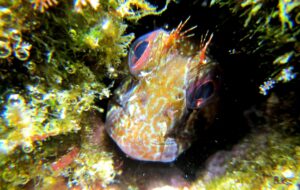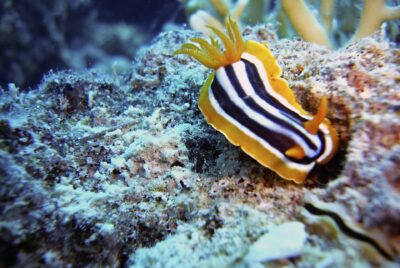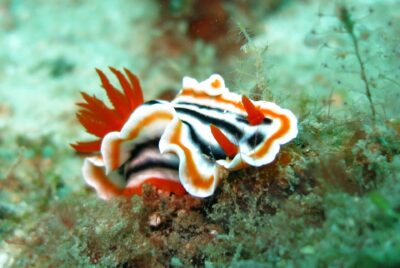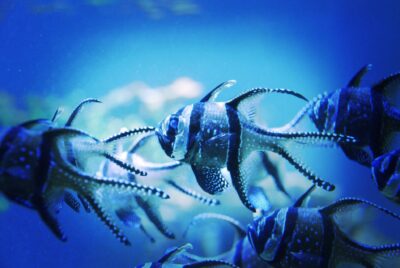Lawnmower Blenny

1.Introduction to Lawnmower Blenny
Hey there, fellow aquarium enthusiasts! If you’re anything like me, you’re always on the lookout for interesting and beneficial additions to your marine setup. Today, I’m diving deep into the world of the Lawnmower Blenny, a true marvel of the aquarium world. These little guys are not only fascinating to observe but also pack a punch when it comes to tank maintenance. Let’s get into it!
a. Overview of the species
The Lawnmower Blenny, scientifically known as Salarias fasciatus, is a distinctive marine fish cherished for its unique appearance and beneficial algae-eating habits. Originating from the Indo-Pacific region, this species is easily recognizable by its elongated body, mottled tan or brown coloration, and the characteristic “blenny smile.” Growing up to about 5 inches in length, Lawnmower Blennies are hardy creatures that adapt well to life in captivity. They possess a curious and active demeanor, often seen perching on rocks or scuttling across the tank floor in search of algae.
b. Importance in aquariums
In the aquarium, Lawnmower Blennies play a crucial role in algae management, earning their name from their ability to “mow down” unwanted algae growth on tank surfaces and live rocks. This not only helps in maintaining the aesthetic appeal of the aquarium but also contributes to a healthier environment by controlling algae populations that can otherwise overwhelm tank ecosystems. Their peaceful nature makes them excellent community fish, compatible with a wide range of tank mates. Lawnmower Blennies are a popular choice among aquarists for their utility and personality, bringing both functionality and charm to marine aquariums.
2.Understanding Lawnmower Blennies
a. Physical characteristics
Lawnmower Blennies, Salarias fasciatus, are notable for their distinct physical appearance which aids in their popularity among aquarium enthusiasts. They have elongated bodies that can reach up to 5 inches in length, displaying a range of colors from mottled tan to dark brown, often blending seamlessly with their surroundings. Their heads are adorned with small, comb-like teeth suited for scraping algae, and their eyes are positioned atop, giving them a wide field of vision. A key characteristic is their continuous dorsal fin, which adds to their unique silhouette. Their skin texture, combined with their coloration, provides excellent camouflage against predators and the reef backdrop.
b. Behavioral traits
Behaviorally, Lawnmower Blennies are a fascinating study. They are predominantly peaceful and solitary, showing a preference for claiming a specific territory within the aquarium. These territories are usually chosen based on the availability of algae, their primary food source, and the presence of hiding spots among the rocks. Lawnmower Blennies are known for their industrious grazing habits, spending much of their time nibbling on algae growths. They exhibit curious behavior, often observed peeking out from their chosen nooks or boldly exploring the tank. Despite their generally solitary nature, they are not aggressive towards tank mates, making them ideal candidates for community aquariums.
3.Tank Requirements for Lawnmower Blennies
a. Ideal tank size
For Lawnmower Blennies, a spacious environment is crucial to mimic their natural habitat and cater to their active grazing lifestyle. The ideal tank size for a single Lawnmower Blenny should be at least 30 gallons. This size allows for sufficient space to establish territories and provides ample surface area for algae growth, which is vital for their diet. Larger tanks are beneficial if planning to house multiple blennies or other species, offering enough room for all inhabitants to coexist comfortably and display natural behaviors without overcrowding.
b. Water conditions
Maintaining optimal water conditions is essential for the health of Lawnmower Blennies. The temperature should be kept between 72°F and 80°F, with a pH range of 8.1 to 8.4, mirroring their natural oceanic environment. Salinity levels should also be maintained at 1.020 to 1.025 specific gravity. Regular monitoring and adjustments are necessary to ensure stability, as fluctuations in water quality can stress or harm these sensitive fish. Adequate filtration and periodic water changes are key practices to keep the environment clean and balanced, supporting the well-being of Lawnmower Blennies.
c. Habitat setup
Replicating a natural reef environment is crucial for the well-being of Lawnmower Blennies. Their tank should include plenty of live rock and crevices to encourage natural algae growth, essential for their diet. The arrangement of rocks and corals should create hiding spots and territories, catering to their need for exploration and refuge. Additionally, a sandy substrate can be beneficial, as it complements their natural habitat and provides a medium for their occasional sifting. Proper lighting is also important to foster algae growth, ensuring that Lawnmower Blennies have a consistent food source. This habitat setup not only supports their physical health but also promotes natural behaviors, enhancing their overall aquarium life experience.
4.Diet and Nutrition
What a lawnmower blenny eats
Lawnmower Blennies primarily feed on various types of algae, including microalgae that grow on tank surfaces, rocks, and decorations. Their diet in the wild consists of benthic algae, which they scrape off with their specialized teeth. In the aquarium, they continue this behavior, acting as natural cleaners by eating algae that form in the tank. While algae make up the bulk of their diet, they may occasionally consume detritus and small crustaceans, making them omnivores. However, algae remain their preferred and most beneficial food source, essential for their health and well-being.
Importance of algae in their diet
Algae is not just a food source for Lawnmower Blennies; it’s crucial for their overall health, providing necessary nutrients that other foods might not offer. Algae consumption helps in maintaining their digestive system’s health and ensures that they receive a balanced diet rich in vitamins and minerals. The act of grazing on algae also keeps their teeth from overgrowing, an issue that can arise in captivity. Without sufficient algae, Lawnmower Blennies can become malnourished, leading to weakened immune systems and increased susceptibility to diseases. Therefore, a steady algae presence in the tank is vital for their longevity and vitality.
Supplemental feeding
While a well-established aquarium might provide enough natural algae for Lawnmower Blennies, supplemental feeding becomes essential in tanks with insufficient algae growth. Offering marine algae sheets or pellets designed for herbivores can ensure they receive adequate nutrition. Additionally, blanched vegetables like zucchini, spinach, or lettuce can be a good supplement. It’s important to monitor their feeding to ensure they are getting enough to eat, especially in community tanks where competition for food might occur. Regularly providing these supplements will help maintain their health and compensate for any dietary deficiencies, ensuring your Lawnmower Blenny remains active and healthy.
5.Compatibility with Other Species
Suitable tank mates for lawnmower blenny
Lawnmower Blennies thrive in a community tank setting, provided their tank mates are chosen with care. Peaceful fish that do not compete aggressively for food or territory make ideal companions. Suitable tank mates include small to medium-sized reef-safe fish such as clownfish, dwarf angelfish, gobies, and cardinalfish. Invertebrates and corals are also generally safe to house with Lawnmower Blennies, as they tend not to disturb these tank inhabitants. The key is to select species that share similar water condition requirements and have a peaceful demeanor, ensuring a harmonious and stress-free environment for all.
Species to avoid
While Lawnmower Blennies are peaceful, certain species should be avoided to prevent stress or aggression. Aggressive fish, such as large angelfish, dottybacks, or aggressive damselfish, can intimidate or harass Lawnmower Blennies, leading to stress-related health issues. Similarly, housing them with other bottom-dwelling species that are territorial, like some wrasses and larger blenny species, might lead to competition for space and food. It’s also advisable to avoid keeping multiple Lawnmower Blennies together unless the tank is large enough to support multiple territories, as they can become territorial towards each other, especially in confined spaces.
6.Lawnmower Blenny and Algae Control
a. Do lawnmower blennies eat hair algae?
Yes, Lawnmower Blennies are known to consume hair algae, making them a valuable asset in controlling this type of undesirable algae growth in aquariums. Their natural inclination to graze on various algae forms includes a particular appetite for hair algae, which can otherwise become a nuisance by overtaking tank surfaces and outcompeting more desirable algae species. By actively feeding on hair algae, Lawnmower Blennies help maintain a balance in the tank’s ecosystem, preventing algae from becoming overly dominant.
b. Benefits of having them in your tank
Incorporating Lawnmower Blennies into your aquarium brings several benefits, primarily related to their efficient algae-eating habits. Their constant grazing helps keep the tank clean and reduces the need for manual algae removal, contributing to clearer tank walls and healthier live rock surfaces. Additionally, their presence can deter the growth of nuisance algae, promoting a more balanced and aesthetically pleasing aquarium environment. Beyond their utility in algae control, Lawnmower Blennies add character and liveliness to the tank with their unique appearance and engaging behaviors, making them a delightful and practical addition to any marine aquarium.
7.Health and Care for the Lawnmower Blenny
Common health issues
Lawnmower Blennies, while hardy, can face health issues if their environment and diet are not adequately managed. Malnutrition is a common concern, especially in tanks with insufficient algae growth, leading to weight loss and decreased immunity. Another issue is stress, often resulting from inadequate tank conditions, aggressive tank mates, or overcrowding, which can make them more susceptible to diseases like Ich (marine white spot disease) and skin infections. Proper attention to their dietary needs and environment is crucial to prevent these health problems and ensure a thriving Lawnmower Blenny.
Care tips for a healthy lawnmower blenny
To keep your Lawnmower Blenny healthy, focus on providing a well-maintained tank that mimics their natural habitat. Ensure the tank is spacious enough with plenty of live rock for algae grazing and hiding spots. Maintain stable water conditions, with regular monitoring and adjustments as necessary. Supplement their diet with algae sheets or suitable vegetable matter to prevent malnutrition, especially in newer tanks with less natural algae. Avoid overcrowding and carefully select tank mates to reduce stress. Following these care tips will help maintain a healthy and happy Lawnmower Blenny in your aquarium.
8.Breeding Lawnmower Blenny’s
Breeding behavior
Breeding Lawnmower Blennies in captivity is a rare and often challenging endeavor, largely due to their specific environmental and behavioral needs. In the wild, these fish exhibit unique breeding behaviors, including the male’s preparation of a nesting site to attract a female. Males become more territorial and display vibrant colors to woo potential mates. After spawning, the male guards the nest, aerating the eggs until they hatch. This level of parental care is fascinating but replicating the precise conditions for breeding in an aquarium requires observation and patience.
Tips for successful breeding
To encourage the breeding of Lawnmower Blennies in captivity, a few key conditions must be met. Firstly, providing a spacious and stress-free environment is crucial; a larger tank can support the establishment of territories and reduce competition. Mimicking natural habitat conditions, including rock structures for nesting sites, can facilitate breeding behaviors. Ensuring optimal water quality and stable parameters mimics their natural breeding conditions. Feeding a varied and nutritious diet enhances their overall health and increases the likelihood of successful breeding. Observing and learning from their behaviors can offer insights into their needs and improve chances of witnessing this rare event in home aquariums.
9.Are Lawnmower Blenny Reef Safe?
- Interaction with corals and invertebrates
Lawnmower Blennies are considered highly reef safe and are a popular choice among reef aquarium enthusiasts. Their primary diet consists of algae, and they do not typically pose a threat to corals or other invertebrates. Instead of disturbing these sensitive organisms, Lawnmower Blennies contribute to the overall health of the reef environment by controlling algae growth, which can otherwise overwhelm coral and compete for light and nutrients. Their peaceful nature ensures that they coexist harmoniously with most reef inhabitants, making them an ideal addition to the reef aquarium without the risk of damaging the delicate ecosystem balance.
10.Conclusion
Lawnmower Blennies are a fantastic addition to both reef and marine aquariums, thanks to their unique combination of utility, personality, and low maintenance requirements. Their diet, primarily consisting of algae, makes them natural cleaners, helping to maintain clear tank walls and healthy live rock surfaces. They are peaceful and can coexist with a wide variety of tank mates, making them suitable for community aquariums. Lawnmower Blennies’ hardiness and adaptability to aquarium life reduce the care effort required on the part of the hobbyist. Beyond their practical benefits, these fish bring a sense of liveliness and character to an aquarium with their curious and engaging behaviors. All these qualities make Lawnmower Blennies not just beneficial for algae control but also a delightful presence that enhances the underwater ecosystem’s diversity and visual appeal.
11.FAQs
- What size tank is best for a lawnmower blenny?
A minimum of 30 gallons is best for a single Lawnmower Blenny. This size provides adequate space for them to graze and exhibit natural behaviors, ensuring a healthy and stimulating environment.
- How can I tell if my lawnmower blenny is healthy?
A healthy Lawnmower Blenny exhibits vibrant colors, active grazing behavior, and a good appetite. Their eyes should be clear, and their skin free from lesions or discolorations. Regular, active movement around the tank is also a good sign of health.
- Can lawnmower blennies live with shrimp?
Yes, Lawnmower Blennies can coexist peacefully with shrimp and other invertebrates. They are not aggressive and typically focus on algae consumption, posing no threat to shrimp or similar tank mates.
- How often should lawnmower blennies be fed?
If your tank does not have enough natural algae, you should supplement their diet daily with algae sheets or suitable vegetable-based foods. Monitor their intake to ensure they are getting enough to eat without overfeeding.
- Do lawnmower blennies need a sand bed?
While not strictly necessary, a sand bed can be beneficial for Lawnmower Blennies. It mimics their natural habitat and can provide a supplementary source of nutrition through microorganisms that live in the sand, enhancing their overall environment.



